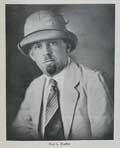
Paul L. Hoefler
|
|
| |
|
|
|
Paul Louis Hoefler was born in Spokane, Washington, in 1893. As
a Hollywood cameraman and cinematographer Mr. Hoefler gained early
notoriety in the late 1920s when, as a member of the Denver African
Expedition of 1925, he returned with what was reportedly the first
film footage of Southwest Africa's Bushmen. Following his Colorado
African Expedition of 1928-29, Mr. Hoefler produced the first
sound film of Africa called 'Africa
Speaks'.
Mr. Hoefler was nominated on November 8, 1929 by George Palmer
Putnam to become a Member of The
Explorer's Club in New York City and seconded for membership
by Fitzhugh Green. On September 18th, 1930, he was honoured
by the Chairman of the Executive Committee of The
Explorer's Club with a testimonial dinner at the Hotel Dixie
on West 42nd street between Broadway and 8th Avenue in New York
City.
|
| |
|
|
One
of the expedition trucks of Paul L. Hoeflers Colorado
African Expedition |
|
| |
|
According to the actual archived application, Mr. Hoefler wrote
that he was the leader of the Colorado African Expedition of 1928-29,
a 14 month journey from July 16, 1928 through September 16, 1929.
In effect, the expedition accomplished the first complete trans-Africa
journey by successfully crossing Central Africa from Mombasa,
Kenya, on the Indian Ocean to Lagos, Nigeria, on the Atlantic
Ocean. According to what Mr. Hoefler wrote in his book, the route
went via "the Kenya Colony, Tanganyika, Uganda, West Nile,
Belgian Congo, French Congo, a trip to Lake Chad in Chad and Nigeria."
The objectives of Mr. Hoefler's expedition were "to study
and makes notes, to photograph and make a motion picture, of
the native and animal life." Additionally, "'more
particularly to study and picture the Nandi and Maasai of East
Africa, the Efe or so called 'hairy pygmies' of the Belgian
Congo, the Sara Kyabe of the French Congo, the lions of Tanganyika,
the bird life at the lakes Baringo and Hannington and the white
rhino on the west bank of the Nile near Lake Albert." During
the expedition Mr. Hoefler collected over forty thousand feet
of motion pictures and was able to secure remarkable scenes
of the rare white rhino. In one scene he captures as many as
eight white rhinos.
|
| |
| |
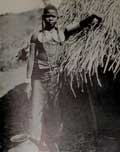 Nandu
Woman
Nandu
Woman |
| |
|
Mr. Hoefler also became an elected Fellow with The
Royal Geographical Society in London (with the Institute of
British Geographers). According to the RGS archives Mr. Hoefler
was nominated for his fellowship by Mr. James B. Pond. The RGS
also confirmed that Mr. Hoefler was made a Fellow of the Society
on February 9, 1931, "most likely as a result of his motor
trips". Mr. Hoefler's name was removed from the membership
lists in October of 1945 but he rejoined the RGS twenty years
later and remained a Fellow until his death in 1982.
For the planning stages of the Colorado African Expedition
of 1928-29, Mr. Hoefler along with his wife Maudie B. Hoefler
and his daughter Jacqueline Hoefler Troyer resided in The
Brown Palace Hotel in Denver, Colorado. The financing of
the Colorado African Expedition of 1928-29 began in a private
banquet room at The
Brown Palace Hotel where Mr. Hoefler and key Denver business
leaders discussed the expedition. Among the original backers
were Mr. Horace W. Bennett who was part owner of The
Brown Palace Hotel at the time; Mr. Frederick Bonfils of
The Denver
Post newspaper; Mr. Charles Biettcher and other prominent
citizens of Denver. Hence the expedition name, Colorado Africa
Expedition of 1928-29.
While Mr. Hoefler was on expedition, both his wife and daughter
lived in The
Brown Palace Hotel. Upon Mr. Hoefler's return from the Colorado
Africa Expedition of 1928-29, he moved back in with his family
at The
Brown Palace Hotel. They remained there while Mr. Hoefler
wrote his best selling book, 'Africa Speaks - A Story of Adventure'
that was released in 1931. On the evening of October 9, 1930,
The Denver Junior Chamber of Commerce honoured Mr. Hoefler with
a dinner at The
Brown Palace Hotel where his motion picture Africa Speaks
was given a special preview screening.
|
| |
|
|
En route during the Colorado African Expedition of 1928-1929
|
|
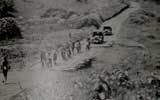
|
|
| |
|
| |
|
The book Africa Speaks - A Story of Adventure' was published by
The John C. Winston Company in 1931. It was dedicated to his wife
Maudie. The book as Mr. Hoefler writes in the foreword, "is
not a story of the motion picture, 'Africa Speaks', but rather
a chronicle of events; a record of strange peoples and wild beasts;
a history of varied adventures, crowded into fourteen eventful
months." It contains maps detailing the route taken as well
as 143 reproductions from photographs taken by the author.
He went on to say, "In the film, the course of the expedition
moves from west to east, so that the lions and other exciting
scenes woven around them can act as the climax of the production.
There were very few lions on the West Coast and no tribesman
comparable to the Maasai and the Nandi. Otherwise it would have
been possible to follow in the picture the actual route of the
expedition just as it will be presented in this book, that is
east to west."
The movie 'Africa Speaks' was produced in 1929 and officially
released in 1931. It was a Mascot Production filmed by Mr. Walter
Futter and Mr. Hoefler. In the credits Mr. Futter is listed
as the director, Mr. Hoefler the actor and the movie narrator
was Mr. Lowell Thomas. The film has been referred to as a "sensational
account of an expedition to the 'Dark Continent'. Footage from
it was later interpolated into many jungle-themed adventure
movies. There is also some remarkable footage of the Wasara
tribe of the Congo and African wildlife that Hoefler captured.
Mr. Edward Brens, a pioneer of production sound recording in
the first days of "talkies" who worked with legendary
film star Douglas Fairbanks and D. W. Griffith is quoted in
his book "Mr. Brens Goes to Hollywood" published by
Scarecrow Publishing that he too worked on the motion picture
'Africa Speaks" Mr. Brens writes, "My next assignment
was an odd kind of film, 'Africa Speaks'. Some film historians
refer to it as a documentary film but it was far from being
one. "
He continued, "A cameraman/promoter/adventurer named Paul
Hoefler raised money in Colorado and went to Africa to make
a film; he called his venture 'The Colorado African Expedition'.
Hoefler shot a great deal of footage of African wildlife and
African natives. He had a story in mind, but the film was not
well-organized and needed connecting scenes to give the material
a coherent storyline. Hoefler sought to market his film, and
entered a partnership with a producer, Walter Futter, who brought
the deal to Columbia. It was a low-cost, low risk project; Columbia
bought it, agreed to shoot connecting scenes and to provide
for finishing costs, including scoring, dubbing and editing.
There was no script. Hoefler and Walter Futter had notes outlining
what we were to film. I was assigned a new boom operator for
'Africa Speaks'. With no script it was an ad-lib kind of production.
We shot on location, in Sherwood Forest, so called because Douglas
Fairbanks filmed his silent film classic, 'Robin Hood' there,
in what is now an area of million-dollar homes, Westlake Village.
Futter and Hoefler would consult their notes, confer, then set
out to find 'lion country'. The entire troupe would follow;
a caravan of sound truck, grip truck, camera truck, and a truck
acquired to match the one Hoefler used in Africa. It bore the
lettering 'Colorado African Expedition' and the entire procession
bumped over the rough terrain. When we found 'lion country'
we filmed connecting scenes that made no sense to us, and then
we were off again, in search of 'gorilla country'. For a long
time afterward, when a director on location was searching for
a set-up, someone who had been on the 'Africa Speaks' crew would
say, "he's looking for gorilla country."
|
| |
| |
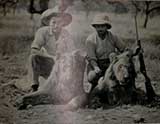 Paul L. Hoefler and guide with a lion.
Paul L. Hoefler and guide with a lion. |
| |
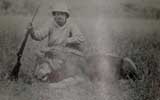 |
| |
Paul L. Hoefler with a Lion |
| |
|
The guide for the East African parts of the expedition was a Mr.
Cottar. Mike and his younger brother Ted went along with Mr. Hoefler
on the expedition. The Cottars later introduced many innovations
to safari that are taken for granted today: they were some of
the first to use vehicles, (beginning with those that assisted
in making the first colour feature film in Africa 'Africa Speaks'
produced by Paul Hoefler 1928), and designed tents and other equipment.
They kept lion, cheetah, leopard, wild dog and chimpanzee for
filming and as pets long before it became fashionable, and were
amongst the first to advertise and operate dedicated photographic
safaris in the early 1920's, guiding and providing logistical
support for some of the most famous safari expeditions ever undertaken,
including that of George Eastman, Martin and Osa Johnson and the
Duke and Duchess of York.
Don Ker was also a member of the team for the Hoefler 1928
expedition. Our research has determined that the trucks used
were most likely 1924 Brockway Model E's that were manufactured
in Cortland, New York. Donald Ker and Syd Downey founded the
Original Ker &
Downey Safaris Kenya Ltd. Ker & Downey today is an active
partnership of 15 guides taking great pride in the operation
of this unique, luxury safari business. As they reflect on their
website, "Our standard of service is of the best quality
and highly personalized - we plan with you to shape each trip
we guide according to your needs. Traditional safaris conducted
by our guides revolve around a mobile, luxury camp in which
the quality of personal attention is unsurpassed. Being self-contained
allows each safari to be both organized and spontaneous; to
visit remote areas, to move on or stay put as mood dictates,
to be free of timetables. A Ker & Downey safari is a customized
adventure. "
In 1936 before setting out on his Asiatic-Africa Expedition
of 1936 Mr. Hoefler founded 'Paul L. Hoefler's World Picture
Service', a negative library containing stills from his travels.
Mr. Hoefler's other documentary films include 'The Bushman'
a detailed account of his Denver African Expedition of 1925,
which was released in 1927, and 'Leopard Men Of Africa' that
was released in 1940. According to our research, "Leopard
Men of Africa concentrates on a tribe of semi-cannibalistic
leopard hunters, seen at work, at home, and at play. The footage
has clearly been re-edited and re-assembled for maximum excitement
value, but it still contains the air of authenticity. No narration
is provided, and none is needed, thanks to the vivid imagery
and the pulsating musical score by James Dietrich. The climax
of Leopard Men of Africa is a tribal ritual ceremony, which
may be a bit too strong for sensitive stomachs."
After serving as the Middle Eastern director of public relations
for the US Air Force during World War II, Mr. Hoefler moved
to southern California. There he began producing films for the
educational market that focused on diverse locations around
the globe, subjects such as Monument Valley in California, Yellowstone
Park in Wyoming, the country of Jordan, and the Panama Canal.
During this period of Mr. Hoefler's life he became a close friend
of Walt Disney. Like Disney, Mr. Hoefler's films on international
cultures were more like television travelogues than films with
real educational value. The Disney-Hoefler link continued into
the 1950s, as Hoefler distributed Mr. Disney's movies in South
Africa in return for Disney's distribution of Mr. Hoefler films
in the United States.
Following Mr. Hoefler's death in 1982 in San Diego, California,
most of his estate was donated to the Phoebe
A. Hearst Museum of Anthropology (formerly The Lowie Museum
of Anthropology) at the University of California at Berkley
and to the Denver
Museum of Natural History.
|
|